Page 1
- Theresienthal [2] Glass beer steins; Florals, Munich Child, Coats of Arms, Medieval People.
- Theresienthal [3] Glass Beer Steins; Adlers, Misc. Designs, White Enamel, Art Scenes.
- Theresienthal [4] Glass beer steins; Prunts, Pewter Mounted, Verses, Jugenstil.
- Theresienthal [5] Glass wine roemers.
- Theresienthal [6] Glass servers, pokals, beakers, wine / punch bowls.
The Guide:
A GUIDE TO RECOGNIZING ANTIQUE (1880 -1910) THERESIENTHAL BEER STEINS AND OTHER DRINKING VESSELS PRODUCED BY THAT FIRM.
NOTE: The original pages on this glass firm were started on 7-13-2005, as a “Word” document and a few photos I had collected up to that point. These both are now much expanded Steve
WHY I STARTED THIS PROJECT: WAY BACK, WHEN:
While I was shopping for beer steins on eBay and other web sites I have found a great deal of confusion on articles produced by what is called “Moser”, “Meyr’s Neffe” , “Harrach” and some other well known Bohemian glass huts that produced heavily enameled vessels of this period being studied, i.e. 1880 -1910. Most of these small decorating techniques and patterns shown in this article were also used by several of the famous Bohemian glass huts before and around the turn of the 20th century. The small white dot patterns were used by many firms such as Harrach and Theodor Witzka to name just two. However, the other firms seldom used the white dot patterns as many times on the same piece as Theresienthal. In the case of the Harrach firm, they would use both white and gold dot patterns on the same piece, sometimes alternating. Harrach, Eggermann, Phofl and other Bohemian firms of the time also used a much different shade of green glass, mostly a bolder and darker green. The Heckert firm used a very similar color glass but the vast majority of their items are signed with “F/H” and a number. The closest in quality and decor were items made by Josephinenhutte, which was also located in Bavaria. Please see the “Not Thereseinthal” section towards the end of this article.
I believe that once those characteristics that I attribute to the Theresienthal factory, which henceforth may be shown in this document as simply: “T-H”, are seriously studied by the use of many comparative photographs, perhaps many more steins and other drinking vessels will be recognized by novice collectors as being produced by this firm.
There is no known catalog or reference book written in English devoted to Theresienthal beer steins (tankards), pokals and roemers that I know of; as of the date of this latest writing (now late 2010.) The one and only book on Theresienthal glass I have seen is about their wine glasses produced in the “Art Nouveau” period. But luckily for me, (and now other glass beer stein collectors) it had one photograph on the very last page showing a ‘roemer’ with the gold leaf trimmed “Flowers, leaf and vine” design, same as one I had bought in Kentucky year ago. (See right below.) This is what started my collection of these gorgeous pieces of enameled glass from old Bavaria.
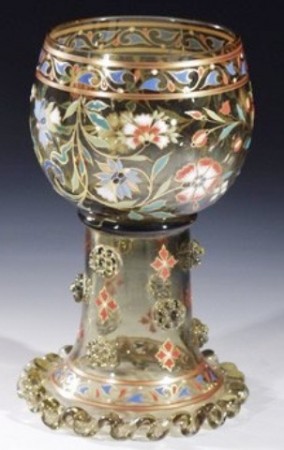
This is my first Theresienthal enameled roemer, the one that started my quest. It was purchased in a private owner antique shop in Georgetown, Kentucky, many moons ago and has now lead to those “wines” and of course many steins and pokals within “From Which To Drink”, which is my collection’s name.
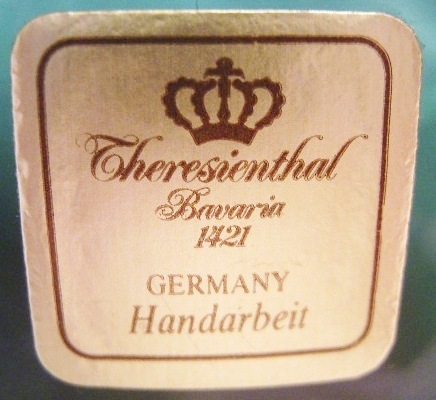
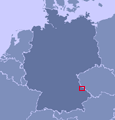
Below is a short history taken from: http://www.theresienthal.de/tthal/geschichte/fs_geschichte_1.html
THE BEGINNING:
One must remember that even after immersing oneself in all this information, the reader will still not be able to identify ALL the different drinking vessels this firm made.
NOTE: THE READER WILL ‘PLEASE’ REMEMBER THAT THE ATTRIBUTION ON A LOT OF THESE PIECES IS STRICTLY THE OPINION OF THIS AUTHOR!
However all of these opinions are based on observation and comparisons of pieces, along with 39 years of German antique drinking vessel collecting experience (Wow Smith, you really are an old duck aren’t you?)
I have tried to use the ‘Alpha” equals “Beta” method of reasoning and logic in determining what is and what isn’t a Theresienthal drinking vessel; that is: if A equals B, and B equals C, and C equals D, then D also equals A.
IDENTIFYING “THE MAJOR 21 CHARACTERISTICS” OF THERESIENTHAL (‘TH”) DRINKING VESSELS AND STEINS. (photos below script)
[1] Very consistent and distinctive colors of their colored glass; especially their greenish yellow tinted glass used for beer steins and other vessels. NOTE FROM STEVE: SCI auctioneers long ago started using the wrong word for this color glass. They use “amber – this color is anything but amber. It is usually a light yellowish – green. (This is just one of the many stein collecting misnomers used every day now by uneducated collectors. I will endeavor to write an article defining all of these sometime in the future.) Other prominent colors used in their beer stein manufacture were: blue, cranberry, orange, and light brown (root beer.)
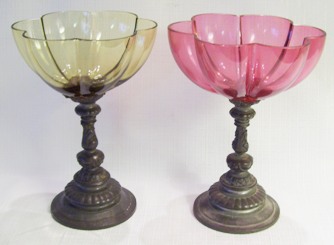
Theresienthal’s (TH’S) cranberry color is to the right. These are wine glasses, and the pewter stems were done by J. Lichtinger, in Munich, Ca. 1890.
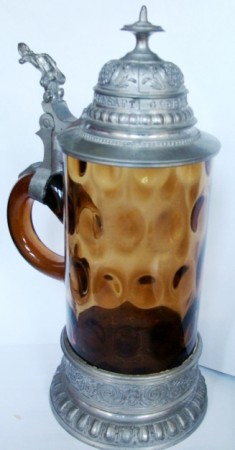
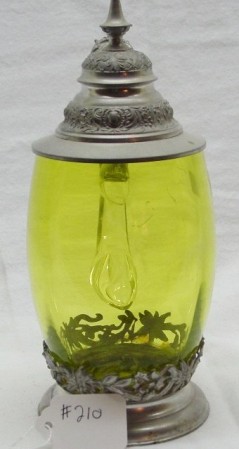
[L] TH’s “Root beer.” [R] A much different shade of green. NOTE: See “sky blue” in No. 15 below.
Just below ▼: TH’s regular color of a yellow green combo.
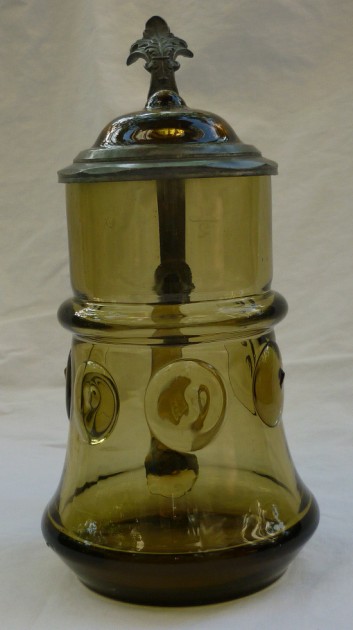
[2] Thin, gold leaf lined flowers and leaves.
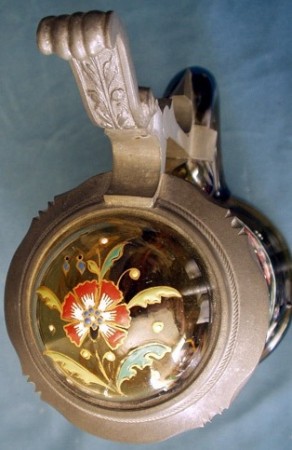
[3] Use of single gold leaf bands around the body.
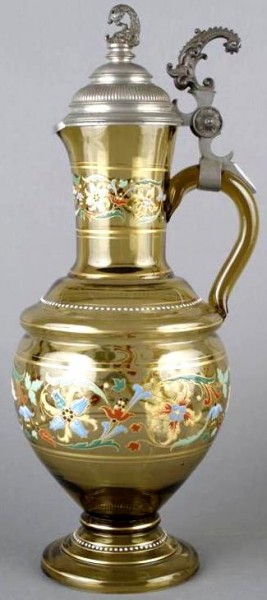
[4] Use of a small white dot patten around the body, or neck of a stein or beaker.
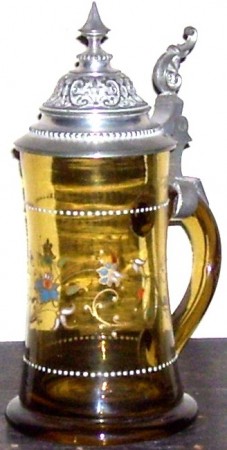
[5] Finely detailed pewter lids or mounts, by either the firm G.Th.M or Jos. Lichtinger, both of which were located in Munich, which was nearby. “E.D. RAU- MUNCHEN”, is also seen as the maker of standard domed type lids with ball thumblifts.
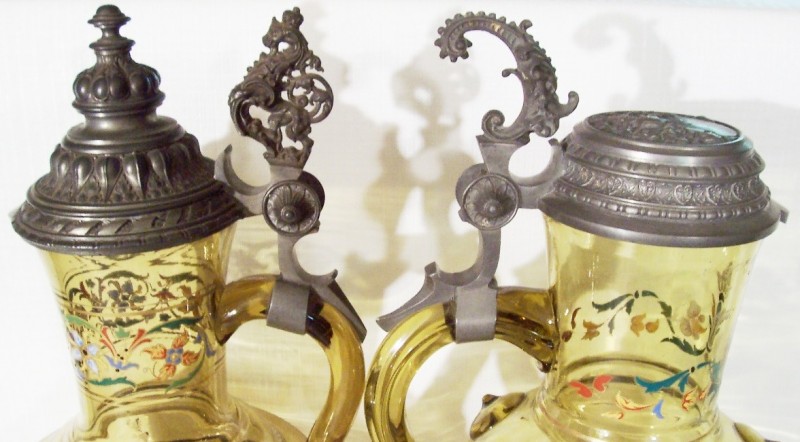
NOTE For a typical G.Th.M thumblift used on half liter steins, see No. 2 above.
[6] An extensive use of prunts, of which all colors were used, but the very prominent use of the dark blue prunts on their green glass bodies sets many a T-H apart.
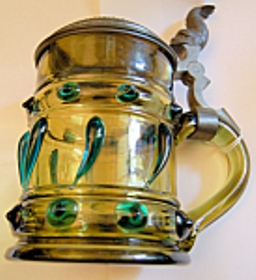
[7] Many of Theresienthal’s steins and roemers have a twisted glass rod (mostly called rigaree , (SPELLING ?) by the stein auctioneers, but this is a misnomer, it should be called “crimped” ) applied to the base of the stein, and sometimes the neck.
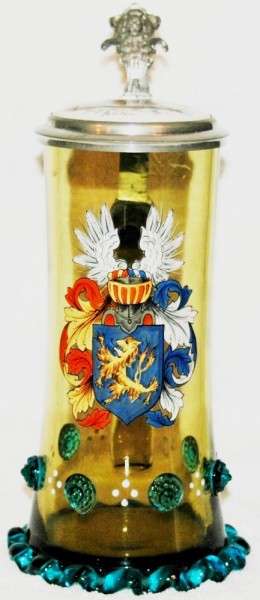
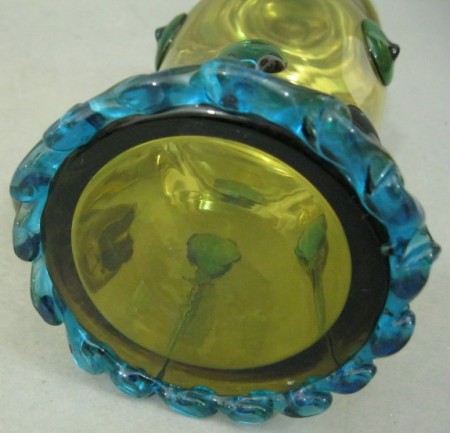
[8] A serrated edge on a glass rope ring around the neck or stem of wines, and also used on a few steins.
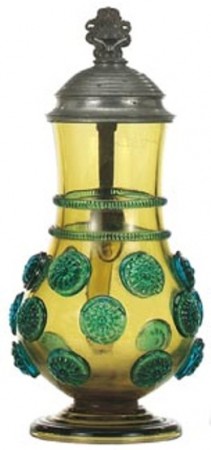
[9] Very bright and consistent enamel colors for decor on their leaves, etc. such as their orange, green and blue.
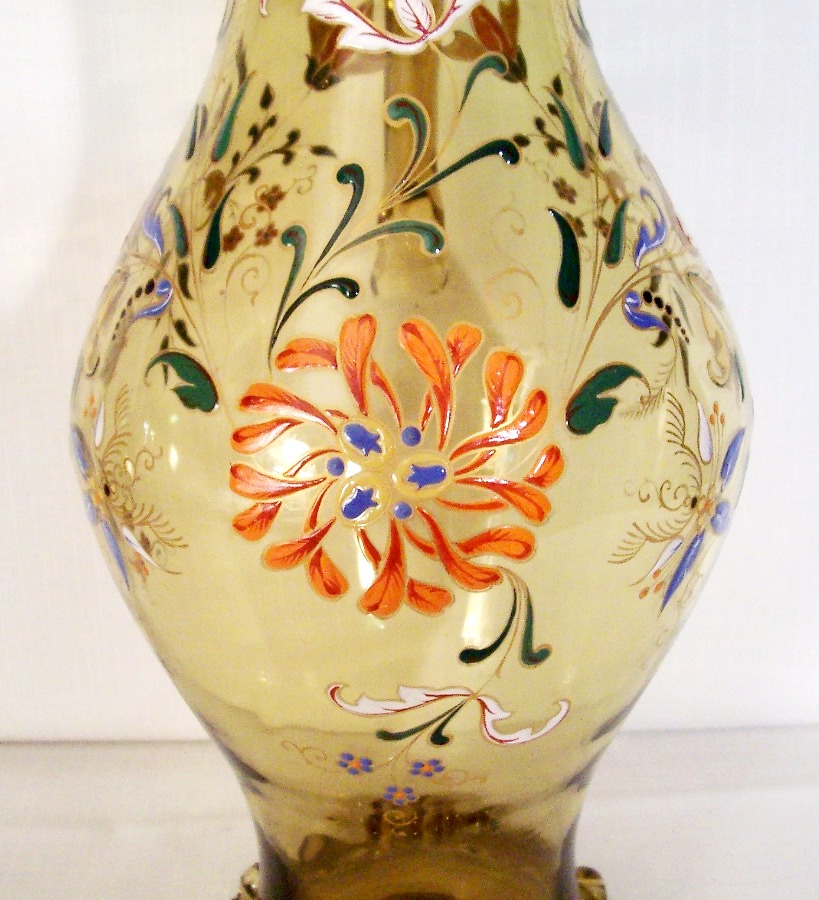
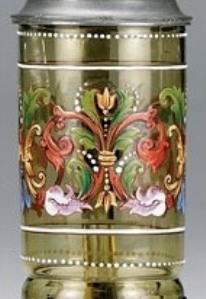
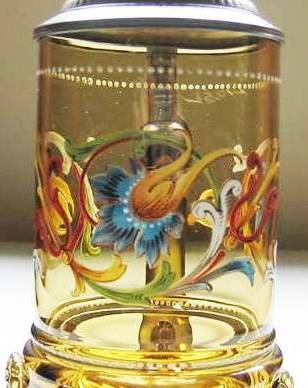

[10] A light and medium tan and cream used for scrolls and vine designs, etc. the leaves /scrolls are usually one half one color, and one half the other.
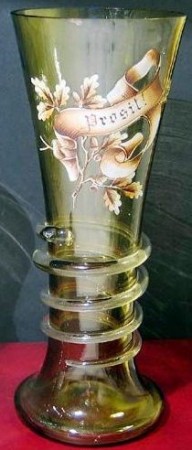
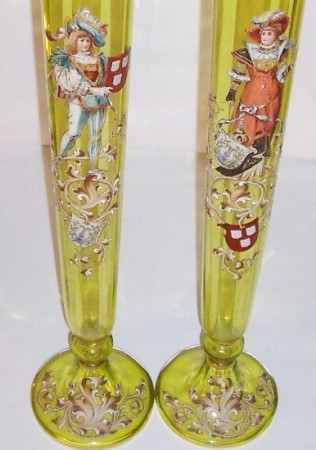
[11] Bright red halos and white scrolls most often beginning with TH’s red-orange letter, for the “Münchner Kindl” series of beer steins. These can also be found on other smaller vessels such as beakers and wine and schnapps cups.
![1r MUNICH MAID have this one [q]](http://www.steveonsteins.com/wp-content/uploads/2010/07/1r-MUNICH-MAID-have-this-one-q-260x600.jpg)
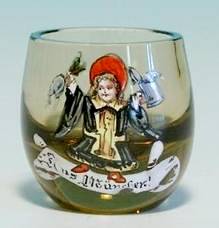
12. Defregger (and other artist’s) scenes in a white dotted square. Most have the dots, but not all do.
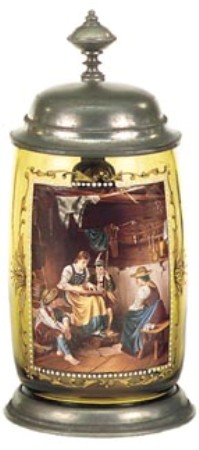
[13] German phrases and / or bright enameled capital letters at the beginning of phrases, mostly red.
Both below are 1880- 1900 versions.
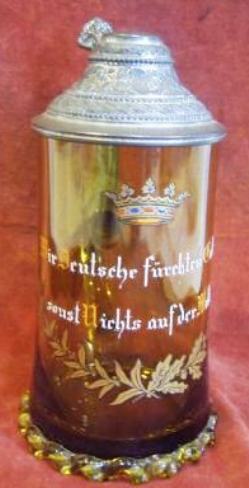
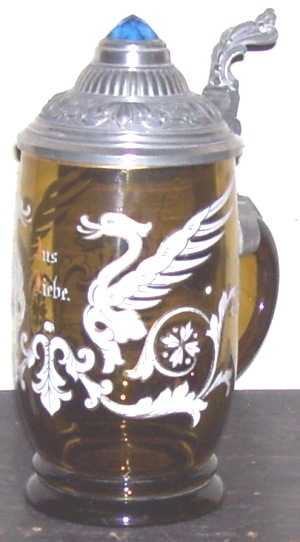
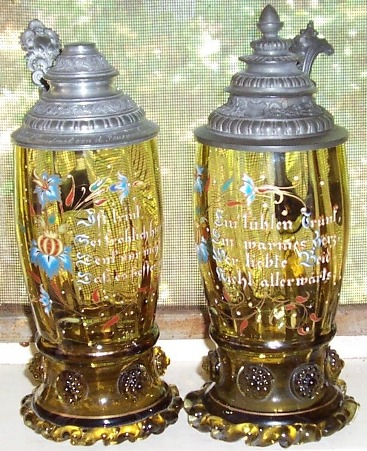
[14] All white enameling.
![1R a HERMANN WITH VERY LARGE WINGS - ENAMELED SERVING STEIN [2]](http://www.steveonsteins.com/wp-content/uploads/2010/07/1R-a-HERMANN-WITH-VERY-LARGE-WINGS-ENAMELED-SERVING-STEIN-2.jpg)
[15] An inside the body “thumbprint” pattern: the outside is finished smooth ( fire polished) with the “thumbprint” (mold) on the inside and in a very small relief towards the middle .
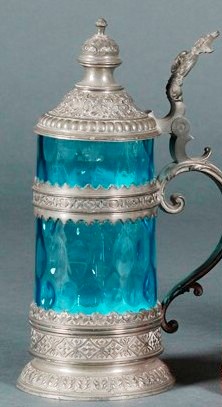
[16] A very distinctive “C” shaped handles that most often sit low on the stein”s body – NOTE: not all T-H steins have this feature.
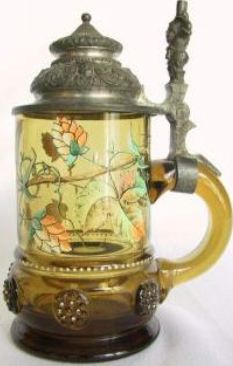
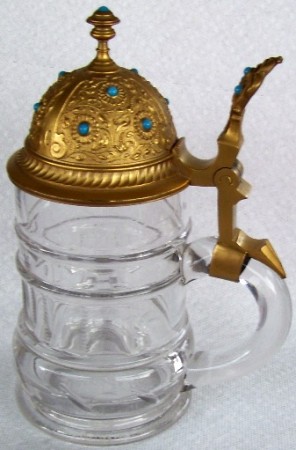
[17] Their own distinctive Imperial Adler (Eagle) “Arms” along with the German Imperial Crown and banner as its shield’s header.
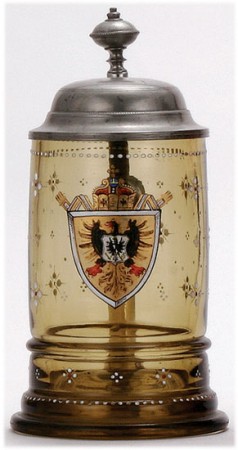
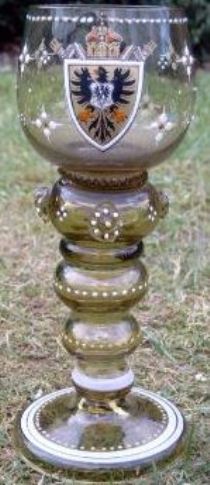
NOTE: The Imperial Adler has the quartered Prussian eagle emblazoned on its chest. Usually also shown with a four point star, with a red middle dot design on the body.
[18] Rounded edge bases with indented bottoms.

![1r MUNICH MAID have this one [q]](http://www.steveonsteins.com/wp-content/uploads/2010/07/1r-MUNICH-MAID-have-this-one-q-260x600.jpg)
[19] Colored glass steins with fancy pewter mounts, lids, and thumblifts made by Jos. Lichtinger’s firm in Munich, Germany, Circa 1880-1900.
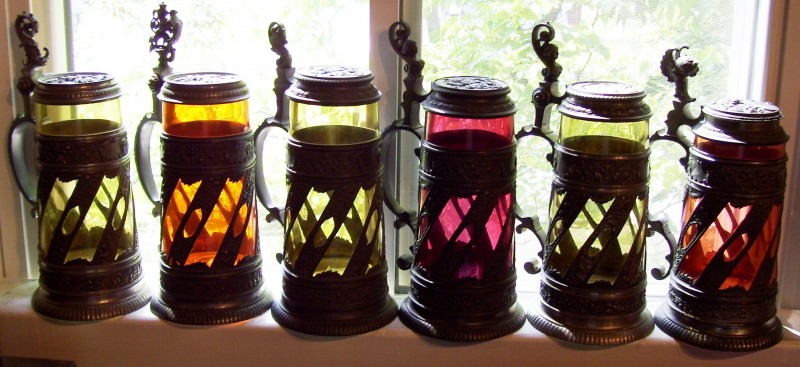
ABOVE: A series of colored glass steins (one came in clear glass also) with same body mounts but with different lids and thumblifts by Jos. Lichtinger, Munich.
[20] A glass lid insert with a matching enameled design, same as on the body.
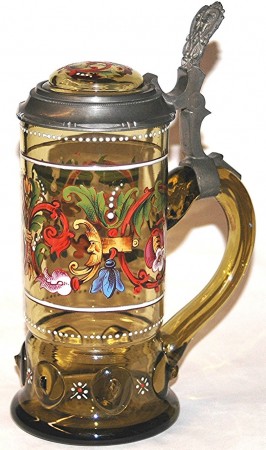
[21] Theresienthal also used the “LAZY H” capacity mark(s) on the right side of their glass bodies.
In 2002 David Harr, a SCI Master Steinologist and a personal friend of mine, released two years of his research regarding the various unique “signature capacity marks” used by the makers of stoneware and earthenware steins in Germany during the so called “Golden Age of Stein Production.”
It appears that each stein producing factory had a specific way of marking the capacity level on the outside of the stein. After David’s work the majority of factories could now be determined simply by knowing these capacity marks, without need of a factory mark stamped on the bottom as was common with the firms such as ‘Gerz’ or ‘Merkelbach-Wick’.
Unlike many of the pottery and porcelain steins, “most” glass steins. including Theresienthal’s, are not marked with a manufacturers mark. While collecting, I had noted a vast number of steins I thought were made by Theresienthal had certain characteristics (white dots, gold rimmed enameled leaves, dark blue prunts, etc. (see list just above.) I also began looking to see if they had a specific type of engraved capacity mark. While attending the Beer Stein College in Springfield, Mass. in 2008, (organized by Mr. Harr) I had ample opportunity to survey hundreds of glass steins (and many more since then.)
All of those, which I thought were Theresienthal’s, had the “engraved” horizontal slash with small diagonals on both ends, which I am now calling: the “Lazy H” capacity mark(s).
Below: A few of the “Lazy H” liter marks that are to be found on Theresienthal steins:
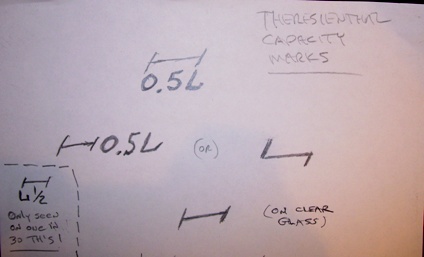
“The Lazy-H” capacity mark on 2 Theresienthal glass steins:
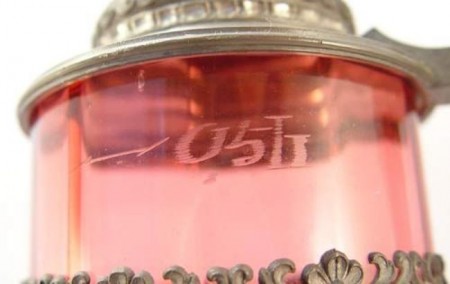
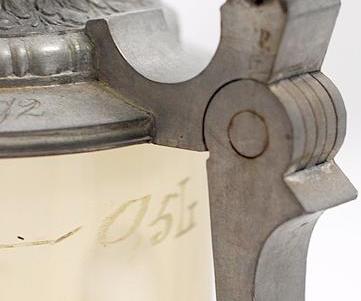
SO WHERE DOES THIS LEAVE US ?
So, for any such vessel having all these attributes, the percentage would have to be up to 95 or 100%!
Please see the next 3 WEB PAGES for more photos of “TH” steins and their other products.
 “Whenever I fill out an application, in the part that says “In an emergency, notify’”, I put “DOCTOR.”
“Whenever I fill out an application, in the part that says “In an emergency, notify’”, I put “DOCTOR.”

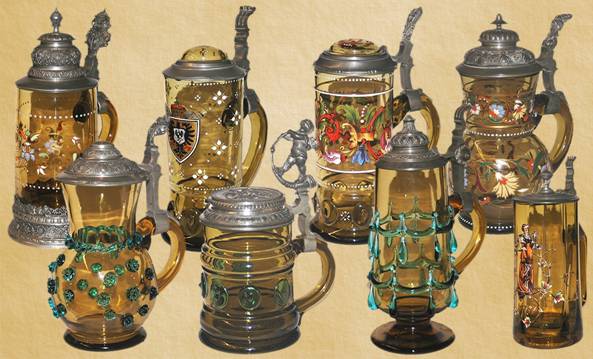
Leave a Reply